

In 1419, Bartolomeo Massoli gave his niece Maddalena Bartelluccio a house near San Giovanni del Fosso so that she could establish a small female community of Franciscan tertiaries. In 1427, this community seems to have entered the congregation that the blessed Angelina da Marsciano had established, which was based at Sant Anna, Foligno. Pope Martin V approved the congregation in 1428 and Pope Eugenius IV recognised the community of Sant’ Antonio as part of it in 1436. Margherita di Onofrio Bartolini, who had made her profession in front of Angelina da Marsciano at Foligno in 1427, is recorded as living with the community near San Giovanni del Fosso in 1440 and as its “Ministra” in 1444.
The sisters sold this house and began to buy property on the present site in ca. 1445. They built a double church (one for their own use and one for public services) in ca. 1455, the year in which Pope Callistus V subjected it to the authority of the Observant Franciscans from the Convento di Monteripido. The sisters’ association with Monteripido must have become more important in 1461, when the congregation to which it had belonged was dissolved. However, the first sign of controversy about the vexed issue of clausura emerged at this time: in a bull somewhat optimistically beginning: “Ut toletur discursus” (In order to settle the debate), Pope Pius II ruled that they were not obliged to cut themselves off from the community. Despite this support, the friars threatened to withdraw their spiritual from the community in 1469, and were only dissuaded when the Commune insisted that “the imperious friars had brought shock and scandal to the city” in attacking the traditions of a fine institution so “close to the heart of the citizens”.
In 1478, Sister Anna, who had entered the nunnery after the death of her husband, Ludovico di Cristoforo, left property in her will that she directed should be sold to provide funds for an altarpiece for the nuns’ inner church. This is the first mention of such a church, and suggests that the pressure on them to accept clausura was growing.
In 1482, Pope Sixtus IV granted the friars’ request that they should be allowed to withdraw their spiritual guidance from the sisters of both Sant’ Antonio and Sant' Agnese because the sisters’ persistence. They reacted by holding two identical open chapter meetings, and sent notarised minutes of their public arguments on the matter to Sixtus IV. He rapidly moved to diffuse the issue by placing the sisters under the spiritual guidance to the newly-arrived Amadeiti Fathers at San Girolamo.
The leading member of the community at Sant’ Antonio at this time was Sister Ilaria (formerly Margherita), the daughter of Braccio Baglioni. She had joined the Poor Clares of Santa Maria di Vallegloria, Spello in ca. 1455 when she was only 11 years old, but had subsequently run away, apparently because of the laxity of the sisters, and joined the sisters at Sant’ Antonio. She is first documented here in 1462 and seems to have become “Ministra” for the first time in 1467. The sisters’ behaviour in the dispute with the friars on Monteripido probably reflects her strong personality and political influence. (The last documentary reference to her is in 1503, and she presumably died soon after).
The sisters became famous for a distilled medicine that they produced, which was deemed to have been effective during an outbreak of plague in 1497. The Commune rewarded them with an annual donation of grain and in 1527 (presumably because of their continued assistance in times of plague) also gave them the Monastero degli Apostoli (see Walk VII).
In 1566, Pope Pius V issued the bull Circa Pastoralis, which decreed that tertiary nuns other non-cloistered female communities should take solemn vows and adopt clausura. Pressure on the sisters to accept clausura probably intensified from 1568, when Pius V merged the Amadeiti Fathers with the main branch of the Franciscans. They were still resistant in 1571 when, following an apostolic visitation, Monsignor Paolo Maria della Rovere, Bishop of Cagli took over the nunnery. He formally deprived the nuns of the sacraments and sent them back to their families complaining of their “obstinato animo” (obstinate minds). Only when they begged for forgiveness and promised to accept the papal strictures in 1572 were they allowed to return. From this point, they seem to have become dependent upon the Poor Clares of Santa Maria di Monteluce. (The nuns from Monteluce took refuge at Sant’ Antonio in 1643 when their nunnery was threatened during the war between Pope Urban VIII and Grand Duke Ferdinand II of Tuscany.)
The nunnery was suppressed in the period 1798-1800, when the nuns moved to Sant' Agnese. It was suppressed again in 1810-4, and was finally closed in 1817, and the sisters were transferred to the nearby Augustinian nunnery of Santa Lucia. The complex was subsequently radically remodelled, first as an industrial complex and then for use as a residence for female students.
Two Churches
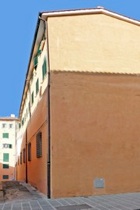
The nuns commissioned an important altarpiece for each of them (as described in more detail below):
-
✴the St Antony of Padua Polyptych (ca. 1468) from Piero della Francesca; and
-
✴what became known as the Colonna Altarpiece (ca. 1504), from Raphael.
Giorgio Vasari saw these altarpieces at Sant’ Antonio, probably during his stay in Perugia in 1566, but he was not specific as to their precise locations. However, Cesare Crispolti was more precise in his guide of 1597:
-
✴the altarpiece by Piero della Francesca was “on the altar of the [public] church”; and
-
✴the “marvellous” altarpiece by Raphael was “in clausura”.
Art from the Complex
St Antony of Padua Polyptych (ca. 1468)
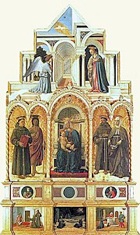
The nuns replaced it on this altar by an altarpiece by Vincenzo Pellegrini in 1608. It was documented soon after in the sacristy. It was moved to the altar of the inner church when the nuns sold the altarpiece by Raphael (below) in 1668. It was confiscated in 1798, returned soon after, but transferred definitively to the Accademia di Belle Arti in 1810. Two of the predella panels were subsequently dispersed but later returned to Perugia. The altarpiece was recomposed in the Galleria Nazionale in 1921.
The figures in the main register occupy a unified space behind the framing, and are set against a backdrop of golden brocade. They depict:
-
✴the Madonna and Child enthroned (in the central panel);
-
✴SS Antony of Padua and John the Baptist (to the left); and
-
✴SS Francis and Elizabeth of Hungary (to the right).
The magnificent panel in the upper storey depicts the figures of the Annunciation in front of an arcade that appears to be a mathematical study in perspective. It is possible that this part of the altarpiece was originally intended to be rectangular, but that it was cut into a cusped shape to harmonise with the Gothic apse in which the altarpiece was placed.
The altarpiece has a double predella:
-
✴The upper predella panel contains half length images in tondi of SS Clare (to the left) and Agatha (to the right). It seems that the empty central panel of the predella was hinged so that the priest could serve the Eucharist to the sisters in the inner church.
-
✴The lower predella panels depict scenes involving the Franciscan saints in the main register:
-
•St Antony raising a child from the dead;
-
•the stigmatisation of St Francis; and
-
•St Elizabeth saving a boy from drowning in a well.
Stained glass (1480-8)
A number of documents in this period relate to stained glass commissioned for the complex from Neri di Monte. None of this survives.
Colonna Altarpiece (ca. 1504)
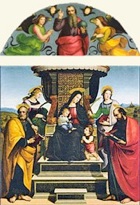
There is no surviving documentation relating to the original commission of the altarpiece. Most authorities date it to ca. 1504, and its commission might have been associated in some way with the death of Sister Ilaria in ca. 1503. Giorgio Vasari saw it in an unspecified location in Sant’ Antonio, probably during his stay in Perugia in 1566, observing that the sisters held it in great veneration. His attribution of it to Raphael is universally accepted. Cesare Crispolti made clear in his guide (1597) that it was in the nuns’ inner church.
The altarpiece was painted on a single piece of wood, except for the figures of SS Francis and Antony (see below), which presumably stood forward of the rest on the base of the frame. It remained in situ until 1663, when the impoverished sisters had it sawn into its component parts so that they could be sold.
-
✴The Colonna family bought the main panel and the lunette in 1677 (which accounts for the usual appellation of the work). These panels had a number of subsequent owners until 1902, when J. P. Morgan bought them at huge expense. He gave them to the Metropolitan Museum, New York in 1916:
-
•The main panel depicts the Madonna and Child enthroned with saints. The baby Jesus blesses the infant St John the Baptist: both are fully clothed, a stipulation of the nuns according to Vasari. The flanking saints are:
-
-SS Peter and Catherine of Alexandria to the left, and
-
-St Paul and another female martyr to the right. Vasari describes this fourth saint as St Cecilia, but other documents relating to the later sale of the work identify her as St Margaret. It is possible that she is St Margaret of Antioch, and that she was included in memory of Sister Ilaria, whose given name was Margherita.
-
•the lunette above the main panel depicts God the Father with two angels.

-
✴Queen Christina of Sweden bought the predella panels and the panels of SS Francis and Antony of Padua in 1663. They stayed together until 1702 but were then dispersed:
-
•the central panel (illustrated above), which depicts the Procession to Calvary, is in the National Gallery, London;
-
•the lefthand panel, which depicts the Agony in the Garden, is in the Metropolitan Museum, New York;
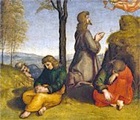
-
•the right panel, which depicts the Pieta, is in the Isabella Stewart Gardner Museum, Boston; and
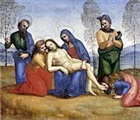
-
•the outer panels of SS Francis and Antony of Padua are in the Dulwich Picture Gallery, London.
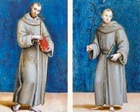
Mystic Marriage of St Catherine (1608)
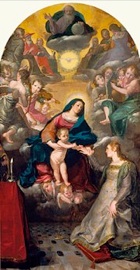
Read more:
V. Garibaldi (Ed.), “Piero Della Francesca: Il Polittico di Sant' Antonio”, (1993) Perugia
For the architecture of the two churches, see the following article in the book above:
P. Lattaioli, “Storia e Architettura del Monastero di Sant' Antonio da Padova”, pp 57-64
K. Gill, “Scandala: Controversies Concerning Clausura and Women’s Religious Communities in Late Medieval Italy”, in :
S. Waugh and D. Diehl (eds), “Christendom and its Discontents: Exclusion, Persecution, and Rebellion (1000-1500)”, (1996) Cambridge
The controversy regarding clausura at Sant’ Agnese and Sant’ Antonio da Padova is described in pp 179-84
Return to Nunneries of Perugia.
Return to Monuments of Perugia.
Return to Walk V.

